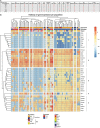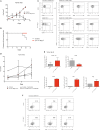The Notch Signaling Pathway Is Balancing Type 1 Innate Lymphoid Cell Immune Functions
- PMID: 29930552
- PMCID: PMC5999736
- DOI: 10.3389/fimmu.2018.01252
The Notch Signaling Pathway Is Balancing Type 1 Innate Lymphoid Cell Immune Functions
Abstract
The Notch pathway is one of the canonical signaling pathways implicated in the development of various solid tumors. During carcinogenesis, the Notch pathway dysregulation induces tumor expression of Notch receptor ligands participating to escape the immune surveillance. The Notch pathway conditions both the development and the functional regulation of lymphoid subsets. Its importance on T cell subset polarization has been documented contrary to its action on innate lymphoid cells (ILC). We aim to analyze the effect of the Notch pathway on type 1 ILC polarization and functions after disruption of the RBPJk-dependent Notch signaling cascade. Indeed, type 1 ILC comprises conventional NK (cNK) cells and type 1 helper innate lymphoid cells (ILC1) that share Notch-related functional characteristics such as the IFNg secretion downstream of T-bet expression. cNK cells have strong antitumor properties. However, data are controversial concerning ILC1 functions during carcinogenesis with models showing antitumoral capacities and others reporting ILC1 inability to control tumor growth. Using various mouse models of Notch signaling pathway depletion, we analyze the effects of its absence on type 1 ILC differentiation and cytotoxic functions. We also provide clues into its role in the maintenance of immune homeostasis in tissues. We show that modulating the Notch pathway is not only acting on tumor-specific T cell activity but also on ILC immune subset functions. Hence, our study uncovers the intrinsic Notch signaling pathway in ILC1/cNK populations and their response in case of abnormal Notch ligand expression. This study help evaluating the possible side effects mediated by immune cells different from T cells, in case of multivalent forms of the Notch receptor ligand delta 1 treatments. In definitive, it should help determining the best novel combination of therapeutic strategies in case of solid tumors.
Keywords: Notch; cancer; cytotoxicity; inflammation; innate lymphoid cells; liver; molecular biology techniques; transcription factors.
Figures










Similar articles
-
Fate Decision Between Group 3 Innate Lymphoid and Conventional NK Cell Lineages by Notch Signaling in Human Circulating Hematopoietic Progenitors.J Immunol. 2017 Oct 15;199(8):2777-2793. doi: 10.4049/jimmunol.1601711. Epub 2017 Sep 11. J Immunol. 2017. PMID: 28893953 Free PMC article.
-
Single-Cell Gene Expression Analyses Reveal Heterogeneous Responsiveness of Fetal Innate Lymphoid Progenitors to Notch Signaling.Cell Rep. 2016 Feb 16;14(6):1500-1516. doi: 10.1016/j.celrep.2016.01.015. Epub 2016 Jan 28. Cell Rep. 2016. PMID: 26832410
-
The Notch signaling pathway involvement in innate lymphoid cell biology.Biomed J. 2021 Apr;44(2):133-143. doi: 10.1016/j.bj.2020.12.004. Epub 2020 Dec 29. Biomed J. 2021. PMID: 33863682 Free PMC article. Review.
-
The E-Id Protein Axis Specifies Adaptive Lymphoid Cell Identity and Suppresses Thymic Innate Lymphoid Cell Development.Immunity. 2017 May 16;46(5):818-834.e4. doi: 10.1016/j.immuni.2017.04.022. Immunity. 2017. PMID: 28514688 Free PMC article.
-
The role of Notch in the differentiation of CD4⁺ T helper cells.Curr Top Microbiol Immunol. 2012;360:115-34. doi: 10.1007/82_2012_227. Curr Top Microbiol Immunol. 2012. PMID: 22653552 Review.
Cited by
-
Natural killers or ILC1s? That is the question.Curr Opin Immunol. 2021 Feb;68:48-53. doi: 10.1016/j.coi.2020.08.009. Epub 2020 Oct 14. Curr Opin Immunol. 2021. PMID: 33069142 Free PMC article. Review.
-
Notch signaling pathway: architecture, disease, and therapeutics.Signal Transduct Target Ther. 2022 Mar 24;7(1):95. doi: 10.1038/s41392-022-00934-y. Signal Transduct Target Ther. 2022. PMID: 35332121 Free PMC article. Review.
-
Antiviral Activities of Group I Innate Lymphoid Cells.J Mol Biol. 2022 Mar 30;434(6):167266. doi: 10.1016/j.jmb.2021.167266. Epub 2021 Sep 22. J Mol Biol. 2022. PMID: 34562465 Free PMC article. Review.
-
Differential regulation of transcription factor T-bet induction during NK cell development and T helper-1 cell differentiation.Immunity. 2022 Apr 12;55(4):639-655.e7. doi: 10.1016/j.immuni.2022.03.005. Epub 2022 Apr 4. Immunity. 2022. PMID: 35381213 Free PMC article.
-
Quantitative characterization of immune cells by measuring cellular signal transduction pathway activity.Sci Rep. 2024 Oct 18;14(1):24487. doi: 10.1038/s41598-024-75666-w. Sci Rep. 2024. PMID: 39424625 Free PMC article.
References
Publication types
MeSH terms
Substances
LinkOut - more resources
Full Text Sources
Other Literature Sources

